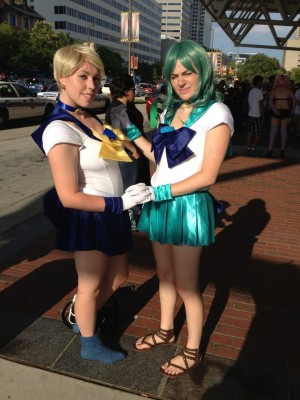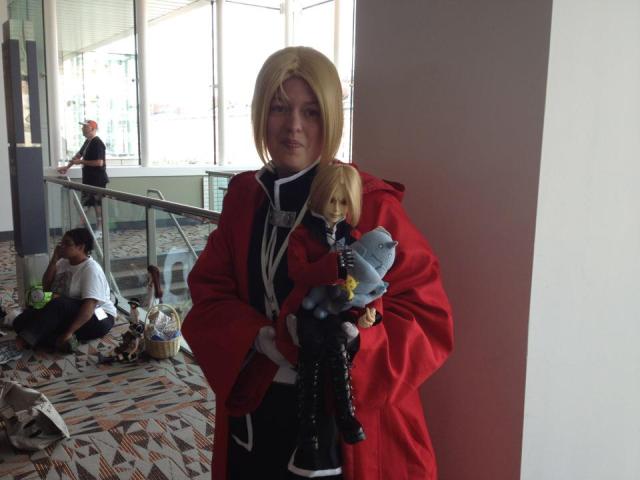The LGBT Panel
After a run-down of common Japanese LGBT terms, we learned some terminology and about the history of the different concepts of queerness. As the panelist Jill Stromberg explained, while Japanese culture doesn’t perceive homosexuality as a “sin” like in societies influenced by the Abrahamic religions, Japan’s strict gender roles mean it is still frequently seen as undesirable and abnormal. Western ideas of sexuality and gender (particularly the idea of sex and gender as separate things, where there was originally no distinction made in the Japanese language) are still new and often viewed as foreign. And despite the popularity of yaoi and yuri anime and gender-bending (but usually not explicitly trans*-identifying) characters, life is still difficult for many actual Japanese LGBT people. Stromberg shared a lot of personal experiences of Japanese queer people, of various different identities, and the backlash they’d received from family and friends and their difficulty fitting in with societal expectations.
One interesting thing that I noticed in this panels’ discussion is that, unlike Western media, of the few characters who identify as bisexual, there are more men than women. Also, we discussed how in anime, there is a sort of an inverse of one of the more common problems with queer characters in Western media: the character who is labeled as gay, lesbian or bisexual but rarely seen in engaging in any kind of same-sex relationship or affection. In anime, it’s more likely that, while we’ll see characters in same-sex relationships (including very affectionate ones), they will resist identifying themselves as any particular label. This could be seen, in one sense, as more progressive (after all, it’s not like characters in opposite-sex relationships have to go out of their way to label themselves as straight, it’s just presumed), but it was clear that it wasn’t viewed that way in the panel. It was more of a way to avoid tying these characters to the LGBT community or to the larger issues with a publicly queer identity. In some cases (particularly in a lot of yuri anime featuring young girls rather than adult women), it’s often done with the implication that the same-sex attraction is a temporary thing; as the relevant TVTropes page notes, relationships between teenage girls in Japan are often encouraged as a way to prepare them for the “real thing” (re: heterosexual relationships) later, but can be seen as “immature” if they continue into adulthood.

Some other unfortunate but common associations with queer characters in anime: Queer female characters are often shown as having strong negative associations with or histories of abuse from men, with it implied that that is the reason for their lack of attraction toward men. And while real-life same-sex relationships can often fall into a butch/femme or top/bottom dynamic, in anime this is pretty much the standard (especially in yaoi), in order to keep the relationship in line with traditional gender roles.
There was a separate discussion on trans* characters: like with LGB characters, characters who were merely “gender non-conforming” were more common than those who identified as some variety of trans* (according to Stromberg, because the Japanese language only recently began to distinguish between sex and gender, “transsexual” is still the default term in Japan rather than “transgender”). Like in Western media, trans* characters tend to be sexualized, and unfortunately, often portrayed as “traps.” Also, being gender non-conforming is often their only trait; rarely are they given development as a character beyond that.
Lastly, there was a sharing of experiences at the end of the panel, where the audience members talked about their lives as LGBT-identified or -allied otaku. Many people talked about how various anime or manga series helped them to come to terms with their identities. One common theme for queer men in the room was the difficulty of dealing with “yaoi fangirls” — women, usually straight-identified, who are huge fans of the yaoi genre and often male-homosexual-shipping in general — because many of them treated their relationships like entertainment for them, demanding impromptu make-out sessions from gay male couples. As I pointed out in my earlier-linked article about brony fanfiction, while many women are turned on by guys making out, their portrayals of it tend to be less exploitative than all the girl-on-girl experimentation we see in media aimed at men. It shows how fandom can develop its own culture with different issues from the mainstream (though, not entirely: as one girl remarked in the sexism panel, lesbians often receive the same treatment in geek spaces as they do in the larger culture about their sexuality being there for public consumption). One of the questions that was left open for the audience at the end of the panel is whether the strong prevalence of enthusiastic yaoi fans makes the anime/manga fandom more accepting of homosexuality (certainly, I know some fans who have become more pro-gay because of their love of yaoi or yuri anime) or whether the objectification and unrealistic depiction of queer men in those works only furthers stereotypes. (It’s worth noting that anime and manga portraying male-male relationships that are created by and for gay and bisexual men, rather than women, are usually classified as a separate genre from yaoi, called “bara.”)

Overall, both of these panels were incredibly informative about the portrayal of gender and sexuality in anime and manga, and what it’s like to be a queer, feminist fan of anime and manga and geek culture. While fan conventions can sometimes be a blur of gathering autographs, memorabilia and photos of your favorite costumes, occasionally you can find that you get to learn something new, too. And to me, that is the most rewarding kind of souvenir.







